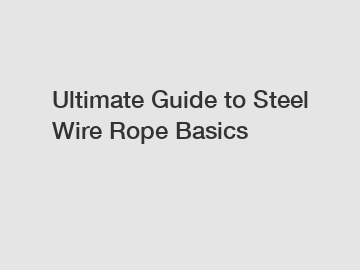Ultimate Guide to Steel Wire Rope Basics
Steel wire ropes are essential tools in many industries, providing strength and durability for various applications. Understanding the basics of steel wire ropes is crucial for safe and effective use. In this ultimate guide, we will break down the key concepts and characteristics of steel wire ropes, as well as how to handle and maintain them properly.
1. Choosing the Right Type of Steel Wire Rope.
- Start by determining the specific requirements of your application, such as load capacity, operating environment, and required flexibility.

- Select the appropriate type of steel wire rope based on factors like construction (e.g., spiral strand, litz wire, or compacted strand), lay (e.g., regular lay or lang lay), and core type (e.g., fiber core or steel core).
2. Inspecting Steel Wire Ropes.
- Before each use, perform a visual inspection of the steel wire rope for signs of wear, distortion, or damage.
- Check for broken wires, corrosion, or flattened areas that may indicate overloading or improper handling.
- Conduct regular inspections using magnification and lubrication to ensure the overall condition of the wire rope.
3. Handling and Installation.
- When handling steel wire ropes, make sure to use proper lifting equipment and techniques to prevent kinking, twisting, or excessive bending.
- Follow manufacturer guidelines for installation, including proper drum spooling, tensioning, and secure anchoring.
- Use appropriate end terminations, such as sockets or clips, to secure the steel wire rope in place.
4. Maintenance and Lubrication.
- Regularly lubricate steel wire ropes to reduce friction, prevent wire wear, and extend the service life of the rope.
- Use a suitable lubricant recommended by the manufacturer and apply it evenly along the length of the wire rope.
- Inspect the condition of the lubrication film regularly and reapply as needed to maintain optimal performance.
5. Inspection and Retirement Criteria.
- Establish a comprehensive inspection schedule based on the frequency of use, load conditions, and operating environment.
- Follow retirement criteria provided by industry standards and manufacturer recommendations to determine when a steel wire rope should be replaced.
- Record and document all inspection results, maintenance actions, and retirement decisions for future reference.
By following these step-by-step guidelines, you can ensure the safe and effective use of steel wire ropes in your applications. Remember to prioritize regular inspections, proper handling, and maintenance to maximize the performance and longevity of your steel wire ropes.
If you want to learn more, please visit our website wholesale star pickets, t post manufacture, Y Post Star Pickets for farm.
- Previous: Top 5 Tips for Maintaining Your Iron Picket
- Next: How does Polywire work?

